
P.D. GRIFFIN
ENCYCLOPEDIA OF MODERN BRITISH ARMY REGIMENTS
Scottish infantry uniforms have long been seen as the most distinctive and glamorous in the army. Highland regiments acquired the feathered bonnet, kilt and hose of their native north lands, though many of them lost the garb in 1809 for a want of Highland recruits. These last looked little different from their English counterparts until after the Crimean War, when a Highland 'doublet' with double Inverness flaps was issued to the Highland regiments. Full Highland attire was acquired by 1881, when the Lowland regiments were provided with doublet and trews. Regimental tartans went on to individualise the uniforms and the Royal Stuart tartan was permitted for pipers of the KOSB, Black Watch and Royal Scots as a mark of royal favour.

Black Watch sword dancers waiting to enter an arena at a showground in the 1990s
When full dress gave way to khaki service dress in 1914 the Scottish infantryman was recognisable by his soft headwear: the glengarry (introduced in 1840) and the flat balmoral bonnet (or tam-o'-shanter), which replaced the glengarry for the trenches in 1915. After the First World War glengarries and bonnets were interchangeable for most orders of dress.
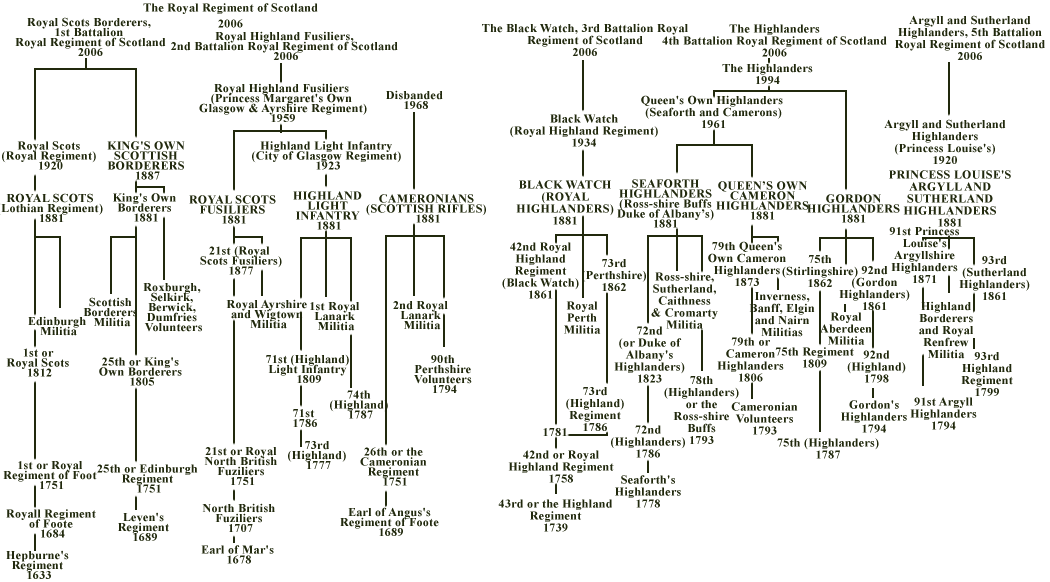
The Royal Regiment of Scotland
Royal Regiment of Scotland (RRS) glengarries and tam-o'-shanters are worn with the large regimental badge on a square patch of Government tartan. The blue glengarry has the red, white and blue squared dicing that was worn by half of the antecedent regiments. Tall black cocks' feathers, worn in the Royal Scots and the KOSB since 1902, are pinned onto the glengarry for ceremonials. The khaki tam-o'-shanters are distinguished by battalion hackles pinned behind the badge - Cameronians' black in the 1st, Royal Scots Fusiliers' white in the 2nd, Black Watch red in the 3rd, Camerons' blue in the 4th and green in the 5th. The green hackle is based on the Sutherland tartan of the A&S Highlanders. The short blue cut feather hackle was awarded to the Cameron Highlanders in 1940 to mark their stand in being the last to wear the kilt on active service. Companies of the 6th and 7th (TA) battalions wear the hackle of their local regular battalion.

Pipers of the Queen's Own Highlanders, c. 1988. Their dress was based on that worn by pipers of the Cameron Highlanders
The regimental badge combines the heraldic Scottish lion rampant, the Cross of St Andrew and the Scottish crown with the motto of the royal Scottish regiments. Another motto, the Seaforths' Cuidich n' Righ (Help to the King) - a reference to feudal times and Alexander III - is earmarked to accompany the thistle emblem as the regiment's collar badge. The old regimental badges are borne by the pipers and the corps of drums.
The Archer green doublet, developed in the latter half of the twentieth century for Scottish No. 1 dress, and blue patrols for senior ranks are retained. The scarlet mess jacket has royal blue facings. In shirt sleeve order officers and senior NCOs wear the light grey shirts of the Royal Highland Fusiliers and Argylls.
All orders of dress (except Combats) may be worn with the kilt or trews, which are of Government tartan - the sombre sett first worn and made famous by the Black Watch. Other regiments built on the tartan by adding colourful lines to create regimental tartans. Pipers still wear the 'music tartans' of their regiments - Royal Stuart in the 1st and 3rd battalions, red Erskine (RSF) in the 2nd and Cameron Erracht in the 4th.
The kilt is worn with a white goat's hair sporran with twin black tassels by officers, senior NCOs and pipers, and a brown leather purse by other ranks. Hose is red and black, as worn in the Black Watch and Gordon Highlanders, and the white spats are fastened with black buttons, a custom of the Gordons that honours the death of Sir John Moore at Corunna in 1809.
The most popular traditional marches among Scottish regiments are Highland Laddie, played in quick time, and In the Garb of Old Gaul, the slow march of a few regiments but none more fittingly than the Royal Scots, whose first forty years of existence were spent in the service of France. Their quick march, Dumbarton's Drums, is reckoned to be the army's oldest, having been recorded in the 1667 diary of Samuel Pepys: 'After meeting with the corps in Rochester, here in the streets I did hear the Scotch March by the drums before the soldiers, which is very odde.' In the presence of royalty, Donizetti's Daughter of the Regiment is played in memory of Queen Victoria, whose father was colonel of the 1st Regiment of Foot when she was born. Princess Mary's March may be played on the pipes after the loyal toast in the mess, a traditional tribute to the Colonel-in-Chief of the Royal Scots from 1918 to 1965.
The regimental quick march of the Royal Highland Fusiliers is a combination of the Royal Scots Fusiliers' British Grenadiers and the Highland Light Infantry's cheeky Whistle o'er the Lave'ot (Whistle over the bits you leave out). The hymn, Abide with Me, was always played after last post on Sundays in the RSF.
The quick march, All the Blue Bonnets Are over the Border was chosen by the Black Watch, the original wearers of the headgear in the eighteenth century, and the Borderers. It was immortalised for the KOSB in 1915 after Piper Laidlaw recklessly played the tune on the parapet of his trench in order to encourage his battalion through a gas attack at Loos. Their slow march included The Standard on the Braes of Mar. The pipes and drums of the Black Watch traditionally play My Home and Highland Cradle Song; they used to play a Crimean Long Reveille on the 15th of every month.

Musicians of the Lowland Band (formed in 1994) deploying to the Gulf in support of 33 Field Hospital Regiment. (MoD)
The Highlanders march to the Pibroch o' Donuil Dhu, as played in both the Camerons and the Seaforths, and The Cock o' the North from the Gordons. Like Piper Laidlaw at Loos, the Highlanders have two examples of a similar devotion to duty. Piper Findlater of the Gordon Highlanders, shot through both ankles in the battle for Dargai (1896), continued to play his comrades on tip the heights with lively pibrochs. At Waterloo Piper McKay of the 79th Cameron Highlanders left the comparative safety of his battalion square to march around its perimeter with Cogadh no Sith (Peace or War).

. A private of the Royal Army Pay Corps assists in the presentation of red roses for the glengarries
Bandmaster Ricketts of the 2nd Argyll and Sutherland Highlanders composed The Thin Red Line in 1908, inspired by the famous nickname of his battalion earned in the Crimean War. It was given official status in 1960, displacing The Campbells Are Coming as the regimental quick march, around the time that The Skye Boat Song was arranged as a slow march for the pipes and drums. The custom of playing Rule Britannia in the Argyll and Sutherland Highlanders' mess is attributed to a nineteenth-century shipwreck that involved a wing of the regiment.
The Cameronians had Within a Mile of Edinburgh Toun (1st Battalion) and The Gathering of the Grahams (2nd Battalion). Thomas Graham founded the 90th Perthshire Volunteers after French Revolutionaries had desecrated the body of his dead wife.
Formation Day (28 March) marks not only the birth of the RRS in 2006, but also that of Scotland's oldest regiment the Royal Scots, raised as Hepburne's Regiment in 1633. Sir John Hepburne, an officer of Scottish mercenaries appointed colonel in the service of Louis XIV, is regarded as the father of the regiment. This antecedence is a point of pride; the nickname 'Pontius Pilate's Bodyguard' is said to derive from an argument with a French regiment over the question of seniority. The French claimed descent from soldiers who had stood watch over the tomb of Christ, but the Scots retorted that they would not have succumbed to sleep if they had been on that watch.
KOSB customs are remembered on three days of the year. Minden Day (1 August) sees the distribution of red roses for the glengarries in the tradition of 'Minden regiments' that gathered roses from the fields in the 1759 battle. St Andrew's Day (30 November) is celebrated with officers and sergeants competing in a light-hearted tournament that culminates with Atholl brose drunk from a quaich. Burns' Night (25 January ) is marked with a sergeants' mess supper, which has a special significance for the KOSB since the poet once joined one of their antecedent regiments, the Dumfries Volunteers.
The Royal Highland Fusiliers' Assaye/Inkerman Day commemorates battle anniversaries of the HLI and the RSF respectively. At the Battle of Assaye in 1803 the 74th (Highland) Regiment won Wellesley's admiration and an honorary colour. Colours were presented to both the 74th and the 78th regiments by the Indian government in recognition of their outstanding conduct in the battle. The prized Assaye colour used to be trooped by a quartermaster in the 2nd Battalion HLI on Assaye Day in memory of Quartermaster Grant, the senior survivor of the 74th, who led the remnant from the field. It was replaced by the City of Glasgow in 1931 and the original, which was damaged by fire in 1918, was laid up. A 1936 replacement modelled on the original has an elephant on a white field emblazoned with ASSAYE, LXXIV and SERINGAPATAM. The buff honorary colour of the 78th was replaced by the 2nd Seaforth Highlanders in 1899, but eventually laid up in Fort George. The Queen's Own Highlanders kept 23 September as Assaye Day to mark the honour. Inkerman Day (5 November) honoured the part played by the 21st Fusiliers in this Crimean battle of 1854. On a foggy day remembered for its seesaw actions of confused skirmishing, the 21st fought a static position at a stone breastwork called the Barrier. In spite of several Russian attempts to force the position the 21st doggedly held on and provided an anchor for soldiers separated from their companies.
Officers and soldiers of the 72nd Highlanders, originally drawn from the same clan, messed together on special days, such as St Andrew's and Hogmanay. The Seaforth Highlanders celebrated the New Year by booting out the oldest-serving soldier at midnight and welcoming in the youngest.

The famous painting of The Thin Red Line of 93rd (Sutherland) Highlanders repulsing Russian cavalry at Balaklava in 1854
Red Hackle Day (4 June) celebrates the time in 1795 when the 42nd Royal Highlanders made a halt at Royston on their way home from Flanders to mark the King's birthday. On the parade each man was given a red feather plume for his bonnet in recognition of gallantry in recent campaigns. The plume was ratified by an army order of 1822 and has been a proud distinction of the Black Watch ever since.

Band of the Queen's Regiment, c. 1990, now part of The Princess of Wales's Royal Regiment
Balaklava Day (25 October) commemorates the 'thin red line' of the 93rd (Sutherland) Highlanders, who stood between the Crimean port of Balaklava and a horde of 3,000 Russian cavalry in 1854. It was William Russell of The Times who coined the sobriquet for the battalion - a strand of hope in a seemingly hopeless situation. The 93rd faced the overwhelming odds with Sir Colin Campbell's exhortation that 'each man must the where he stands', but as the cavalry lumbered over the plain the Highlanders sent a disciplined volley into its midst and halted the assault.
Regimental pet mascots were popular from the reign of George III, with some Highland regiments adopting a stag. Today the Argylls' Shetland pony is the only example in the regiment. Its name Cruachan came from the old war cry of the Clan Campbell; Duncan Campbell of Lochnell was the first colonel of the 91st Highlanders. The first Shetland pony was presented to the 1st Argylls in 1929 by Princess Louise, Duchess of Argyll.
Cameronians Day (12 May) commemorates the regiment that began life in the religious sect known as the Covenanters and joined the army of William III on condition that it would be allowed to keep chaplains of its own persuasion. On 12 May (Founders' Day) a conventicle would be held in the open and picquets posted around the service to symbolise life under the Stuarts, when the Covenanters were persecuted. Rifles were always carried on church parades when suitable racks were available and the march to and from church would be made in silence. Drinking the loyal toast was against the Presbyterian code, so Cameronian officers devised a method of passing a glass round the table without pausing to drink from it.
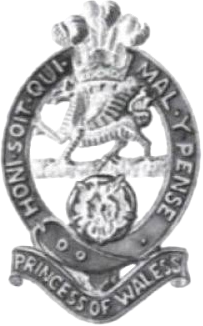
THE PRINCESS OF WALES'S ROYAL REGIMENT
The Princess of Wales's Royal Regiment (PWRR) was formed in 1992 by the merger of the Queen's Regiment (the 1966 host to the four regiments of the Home Counties Brigade) and the Royal Hampshire Regiment. The PWRR title was inspired by Diana, Princess of Wales, Colonel-in-Chief of the Royal Hampshires from 1985 and of the PWRR until her untimely death in 1997. By coincidence the old Queen's Regiment (1661-1959) went under the same PWRR title between 1715 and 1727.
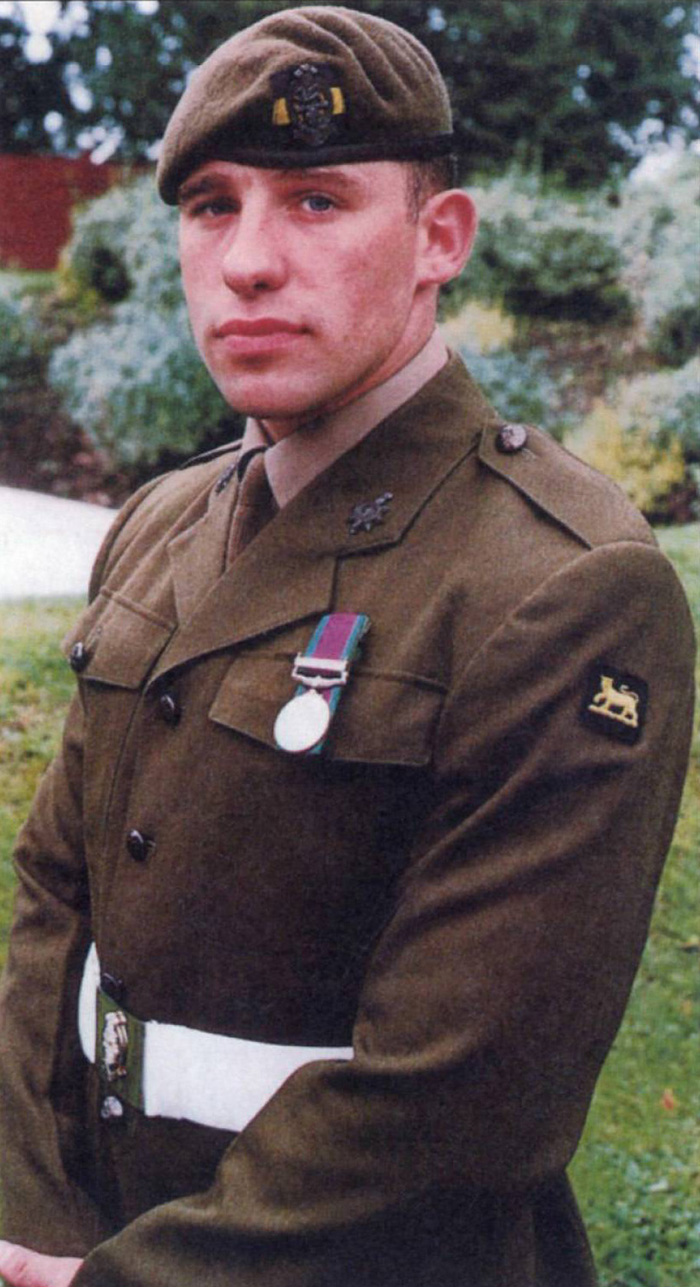
PWRR private in No. 2 dress, 1995. Bronzed buttons are a regimental custom inherited from officers of the Royal Hampshire Regiment. The bronzed badge is pinned to a black/yellow/black patch, the colours of the Hampshires now used on the PWRR stable belt too. (Grenadier Publishing)
The old Queen's and the Buffs (so called from their flesh-coloured facings) date back to the reign of Charles II, making the PWRR the senior English regiment in the infantry. The old Queen's were raised for the garrison of Tangier, part of Catherine of Braganza's dowry to Charles II in 1661; the Buffs, who claimed descent from the London trained bands that went to fight for the Dutch in 1572, were accepted by Charles when Holland repatriated mercenaries loyal to England as the two countries came to war in 1665.
Headquarters are at Howe Barracks in Canterbury, the old depot of the Buffs.
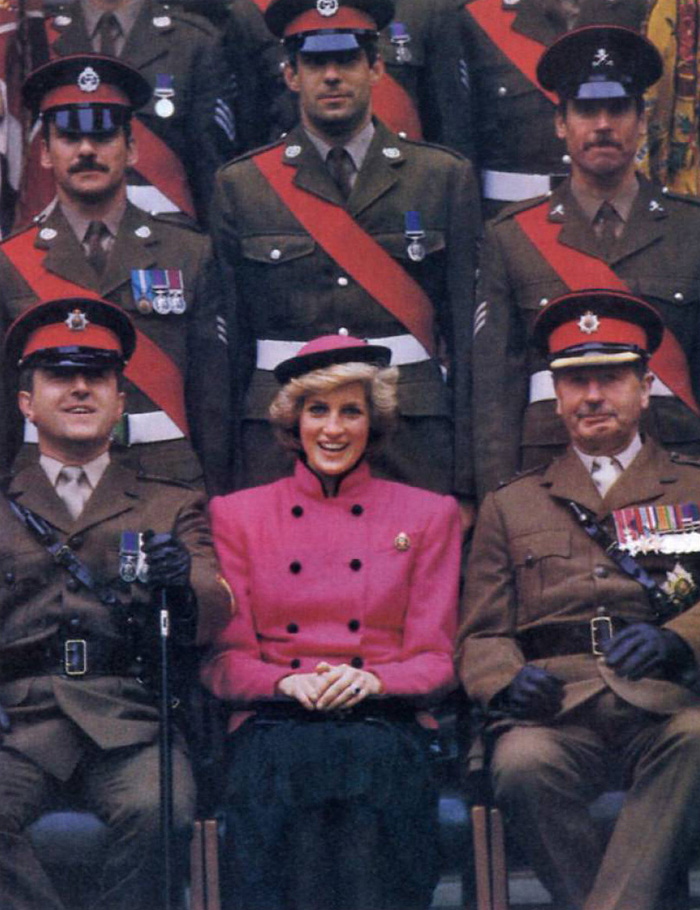
Diana, Princess of Wales, with the Royal Hampshires. The different cap badges are regimental officers' pattern (front row), other ranks (centre) and Army Physical Training Corps (right)
The blue peaked cap has the scarlet band of a royal regiment and the badge of the 1966 Queen's Regiment modified to accept the Hampshire rose. It has four parts: the Prince of Wales's crest, conferred on the 77th Regiment in 1810 (an appropriate ingredient for the PWRR); the Garter belt confirmed to the 35th (Royal Sussex) in 1879 through its connection with the 4th Duke of Richmond KG; a dragon from the arms of the City of London and Elizabeth I, conferred on the Buffs by Queen Anne as a symbol of their antecedence in that place and time; and the Tudor rose of the Hampshire Militia, conferred on the trained bands of Hampshire by Henry V to mark the support given him at Agincourt in 1415, which was adopted by the Hampshire Regiment.
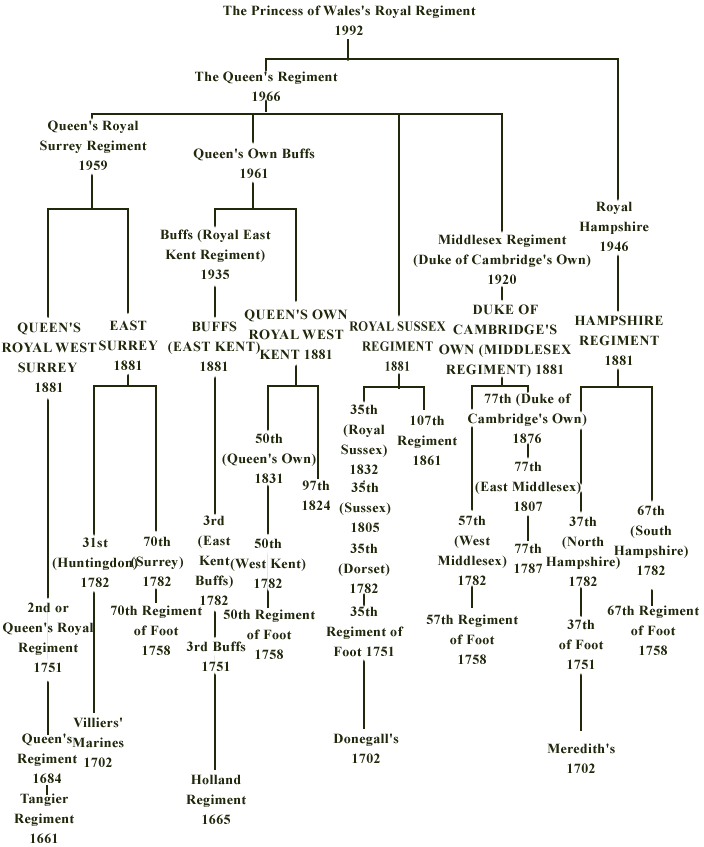
The collar badge, designed for the Queen's Regiment in 1967, embodies the Garter Star (backed by an upright plume) of the Royal Sussex Regiment with the rearing Horse of Kent at its centre. The Roussillon plume represents hat plumes of the French Roussillon Regiment taken by Otway's Regiment (the 35th) as a symbol of victory at the Battle of Quebec in 1759. The White Horse of Kent, with its motto Invicta (Unconquered), is the county emblem once worn by the Kent Militia and adopted by the Queen's Own Royal West Kent Regiment for its cap badge.
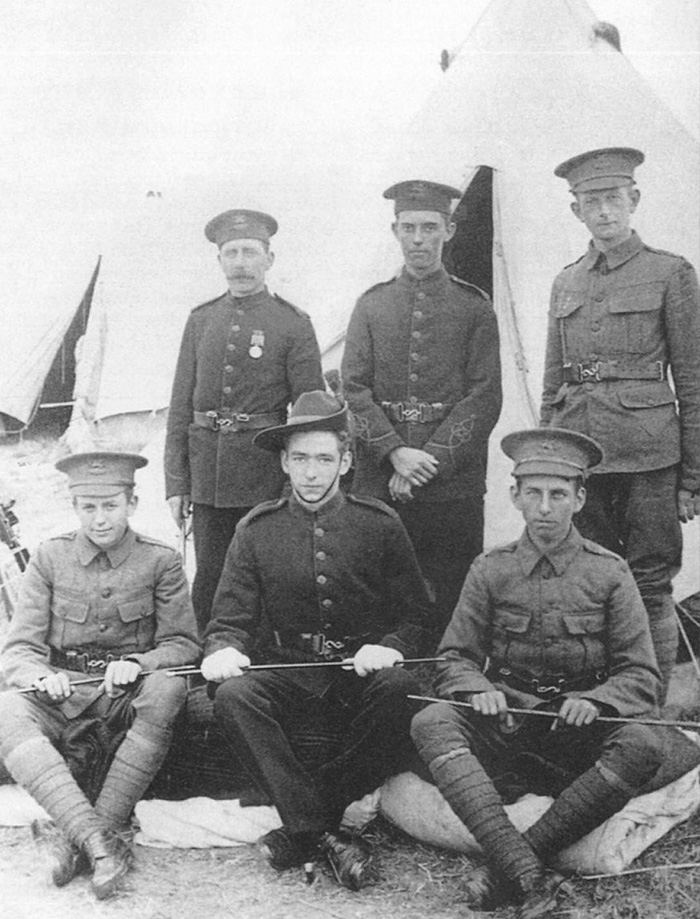
The Buffs' 1st Volunteer Battalion camp, c. 1904, green rifles uniform (centre) and khaki service dress (outer). (Military Historical Society)
Buttons of the regiment, which also date from 1967, are impressed with the lamb and star badge of the Queen's Royal Surreys. The paschal lamb is a religious symbol probably adopted by the Old Tangier Regiment in its fight against the Moors of north Africa. The ironic nickname 'Kirke's Lambs' got attached to the regiment after its bloody handling of Monmouth's supporters in 1685. When the regiment became the 2nd of Foot, the lamb was displayed with one or other of the mottoes conferred on the Queen's after their heroic defence of Tongres in 1703: Pristinoe virtutis memor (Mindful of former glory) and Vel exuviae triumphant (Even the remnant triumph).
Dress jackets and tunics are distinguished by a black square patch on the upper left sleeve bearing a royal tiger in gold. The tiger, which formed part of the badge of the Hampshire Regiment from 1881, was awarded to the 67th in 1826 with the word 'India' for twenty-one years of service in that country between 1805 and 1826. In this period the battalion marched from 'Bengal to Bombay subduing riots, investing fortresses, fighting in hills and jungle, and endured monsoons and disease'.
The regimental quick march, The Farmer's Boy/Soldiers of the Queen, brings together two popular Victorian songs, neither of which had been officially adopted by an army regiment before 1966, when the new Queen's Regiment took the music hall ballad, Soldiers of the Queen, as its jaunty quick march. The Farmer's Boy, a favourite among Wessex regiments, was often played unofficially in the Hampshires, like in the 4th Battalion's Trooping the Swede ceremony to honour 'The Swedebashers' who flocked to the colours in 1914 but never returned. The march was officially adopted by the PWRR on formation.

Seventeenth-century re-enactment group in the dress of the 1680s, when the Old Tangier Regiment returned to London and their new title, Queen's
The regimental slow march, Minden Rose, refers to the rose traditionally worn on Minden Day and was written in 1990.
Former regimental marches played on appropriate occasions are Braganza, Scipio and We'll Gang Nae Mair to Yon Toun (West Surreys); The Buffs and Men of Kent (Queen's Own Buffs); A Southerly Wind and a Cloudy Sky, A Life on the Ocean Wave, Lass o' Gowrie and Lord Charles Montague's Huntingdonshire March (East Surrevs); Royal Sussex, Roussillon, Lass of Richmond Hill and Sussex by the Sea (Royal Sussex Regiment); The Hampshire (formerly The Highland Piper), A Hundred Pipers and Bonnets of Blue (West Rents); and Sir Manley Power, Paddy's Resource and The Caledonian (Middlesex).
The march Old Queen's was banned from being played in public by Queen Victoria because of its distorted version of the national anthem, and was confined to the officers' mess of the West Surrevs thereafter. In the officers' mess of the Buffs it was the custom for the Danish national anthem to be played as a toast was made to 'The King of Denmark'. The connection between the regiment and the Danish royal family began in 1689 when it was made Prince George of Denmark's Regiment of Foot. King Frederick IX of Denmark became Colonel- in-Chief of the Buffs in 1947, as had King Christian X in 1912 and Frederick VIII in 1906. Many Danes fought in the ranks of the Buffs during the Second World War.
Albuhera Day (16 May) commemorates the bravery of the 3rd, 31st and 57th regiments in the Peninsular battle of 1811. The Buffs and the Middlesex Regiment observed the anniversary with a service of remembrance for the appalling losses sustained in the battle. Lt Latham of the Buffs was left for dead after defending his King's Colour but lived to achieve fame as a hero both in and out of his regiment. The Middlesex always ended the day with their Die Hard Ceremony, at which a toast was made to the 'Immortal Memory' of the 'Die-hard' 57th, severely mauled in a deadly firefight with the French. Their nickname came from the dying exhortation of Col Inglis to 'Die hard, 57th, the hard!'
Minden Day (1 August) celebrates the infantry victory over the French cavalry in Germany 1759. Before the taking of Villers Bocage on Minden Day in 1944 the Hampshires stopped to pick roses from a Field to wear on their steel helmets in the tradition started by the 37th at Minden.
The Glorious First of June celebrates the great naval victory off the coast of Ireland in 1794, in which detachments of the 2nd or Queen's Royal Regiment were aboard five ships of Lord Howe's fleet. The 1st Battalion's mess mallet was made from timbers off the Queen Charlotte. A naval crown awarded to the Queen's Royal West Surreys for its part in the battle was shown on regimental buttons and now flies on the PWRR regimental colour.
Salerno Day (9 September), formerly observed by the West Surreys in respect of their TA battalions landing on Sicily in 1943, is perpetuated to include the brigade of Hampshire battalions also present. This date was chosen for the formation of the PWRR.
The East Surreys observed 23 April as Ypres Day, in memory of their 1st and 2nd Battalions on the Western Front in 1915, and 27 June as Dettingen Day, notable for the passing of the Dettingen Cup around the mess table. On 10 February (Sobraon Day) the 1st Battalion colours would be handed over to the care of the sergeants in memory of Sgt McCabe of the 31st and the gallantry he displayed at the Battle of Sobraon - the final defeat of the Sikh army on the banks of the Sutlej in 1846. Officers dining in the mess were required to take their salt from a special cellar with a concealed fragment of the regimental colour carried by the 31st at Sobraon. When salt was taken the fragment was revealed and the officer reminded of his responsibilities, a custom perpetuated by the Queen's Regiment from 1966. In the 2nd Battalion a toast to 'The British Battalion' was made in honour of the composite unit made up of the remnants of the 1st Leicesters and the 2nd East Surreys in Malaya in 1941.

The Die Hard Company, an award-winning display team that depicts the Middlesex Regiment in the 1880s
The Royal Sussex observed Quebec Day (13 September) in memory of Otway's Regiment in Wolfe's last victory. The Royal Hampshires' connection with Gen Wolfe began in 1758, when he became colonel of the 67th. Although he spent most of the year on campaign in Canada, Wolfe found time to visit his regiment twice at its camp near Salisbury before returning to Canada for the last time. Their membership of the Wolfe Society has been inherited by the PWRR.
The Hampshires kept Gallipoli Day (25 April) to commemorate the landings at Helles and Suvla Bay from the HMT River Clyde by the 2nd Battalion in 1915. The 1st Battalion gained the reputation of 'stonewallers' during the war for their tenacity in trench warfare.
The West Rents kept Corunna Day (16 January) in memory of Charles Napier and Charles Stanhope, who together led the 50th in clearing the village of Elvina during the Battle of Corunna in 1809. It became a part of the officers' mess ritual on this day to make a toast to 'The Corunna Majors', neither of whom managed to escape from Spain with the army. Sevastopol Day (8 September) was observed to mark the services of the 50th and 97th Regiments in the Crimean siege of 1855.
The East Surreys were raised as a regiment of marines and cultivated an affiliation with the Royal Marines, adopting their march in 1942. The 50th Regiment served with the fleet in 1778 and took up the custom of piping in to dinner where Rule Britannia would be played, a tradition continued in the West Kents.
In the 1st Royal Sussex the loyal toast was taken seated (naval fashion) and responded to by each officer in turn, a custom perpetuated after the amalgamation of 1966, which went back to the regiment's earliest days in northern Ireland, when Donegall's men spent long periods shut up on ships. In 1702 officers of Donegall's Regiment were ordered to repeat the toast individually so that each man's allegiance to the crown could be tested. When Queen Juliana of the Netherlands was appointed Colonel-in-Chief of the Royal Sussex in 1953, she allowed the mess to toast her health seated, in accordance with regimental custom. The Freedom of the City of Belfast was conferred on the Sussex in 1961. Officers of the 2nd Battalion, without the benefit of this history, would stand for the loyal toast in the normal manner.
A large sea-green colour kept permanently in the protection of the officers' mess was handed down from the Queen's Royal West Surreys. The Queen's carried a colour with the cypher of Catherine of Braganza in the belief that it was a gift from the Queen, but it was extra to the regulation pair of colours after 1750 and was ordered not to be carried in the ranks again. Colours of this regiment have always carried the Queen's cypher.
We have much more interesting information on this site.
Click MENU to check it out!
∎ cartalana.com© 2009-2025 ∎ mailto: cartalana@cartalana.com